Margalya Press
TIQQUNEI HA-ZOHAR MARGALYA ENGLISH TRANSLATION - 7 VOL. SET
TIQQUNEI HA-ZOHAR MARGALYA ENGLISH TRANSLATION - 7 VOL. SET
RRP US $750
The first ever complete English translation of the foundational kabbalistic text Tiqqunei ha-Zohar is:
COMING SOON!
Tiqqunei ha-Zohar (TZ), sometimes called Tikkunei Zohar, is one the most important books of Kabbalah ever produced. It has profoundly influenced Jewish ideas and practice for the past 700 years.
Unlike its sister text, the Zohar, which has multiple English editions, TZ has never been fully translated into English or any Western language.
Until now.
AN ESSENTIAL ADDITION FOR YOUR JUDAICA LIBRARY
The Tiqqunei ha-Zohar Margalya (TZM) annotated bilingual English translation will fundamentally change the landscape of kabbalistic study for the English speaking world and beyond. An ambitious work of scholarship, TZM will be an important addition to any serious home or institutional Judaica library.
Translated by David Solomon, this ground-breaking bilingual publication will be available late in 2024. Solomon, a highly experienced translator of Hebrew and Aramaic texts and Managing Editor at Margalya Press, has dedicated more than a decade to the creation of this extraordinary work of scholarship. His translation is a remarkable example of clarity and beauty, while also preserving the poetry of the original text.
TZM includes six volumes of bilingual translation and a single volume of the translator’s annotations, notes, and commentaries.
Tiqqunei ha-Zohar Margalya will appear as a limited print edition. To ensure you secure your set, please register below to stay at the front of the queue.

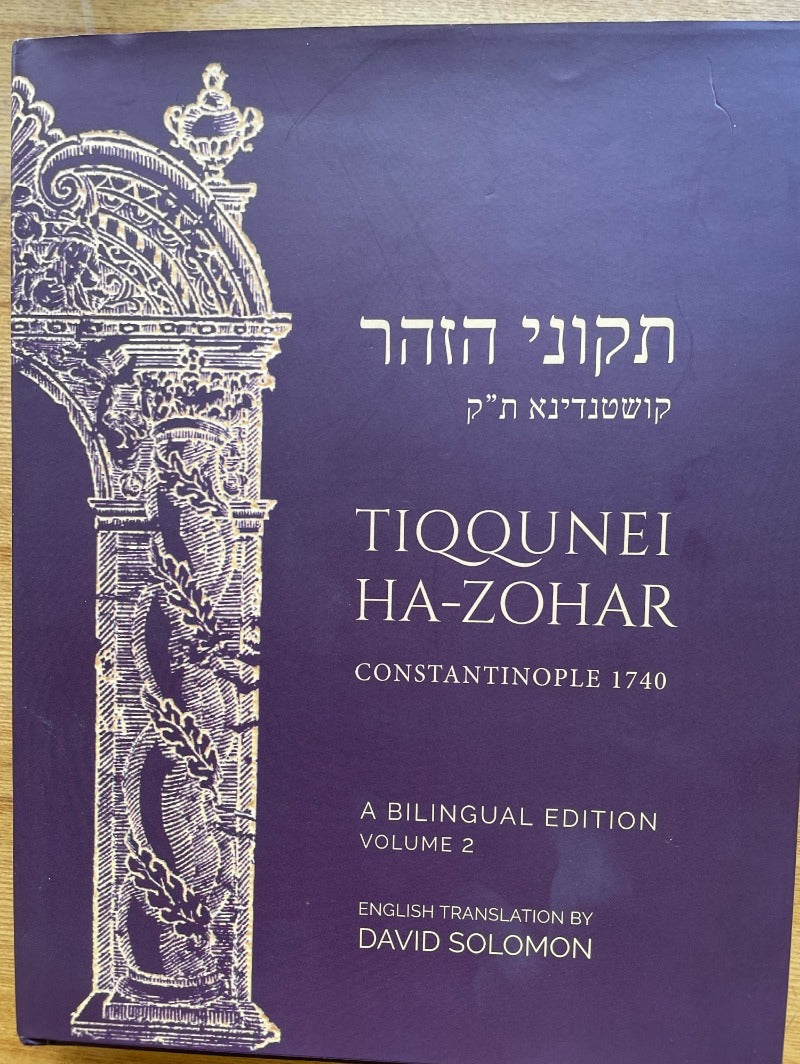

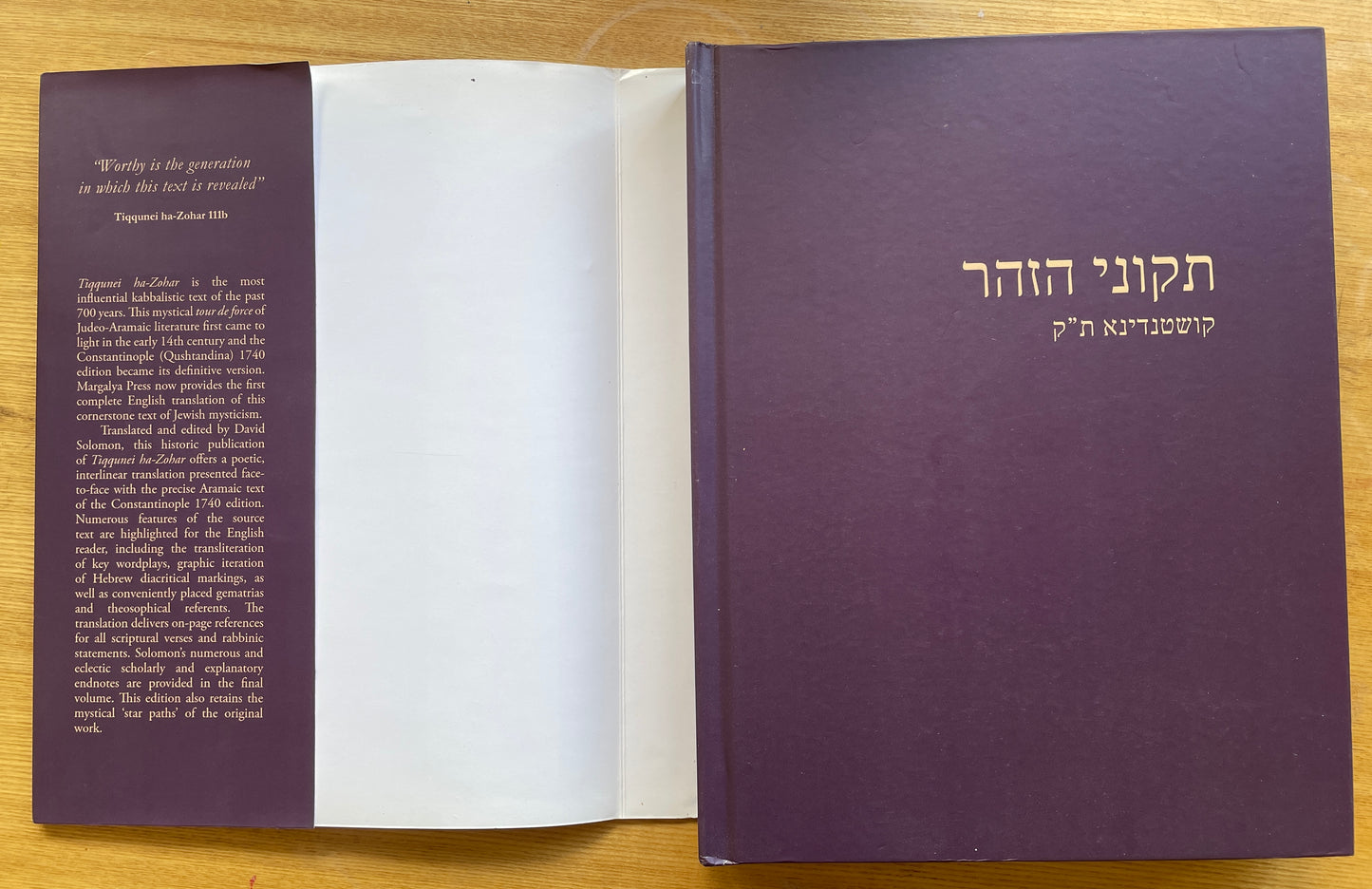
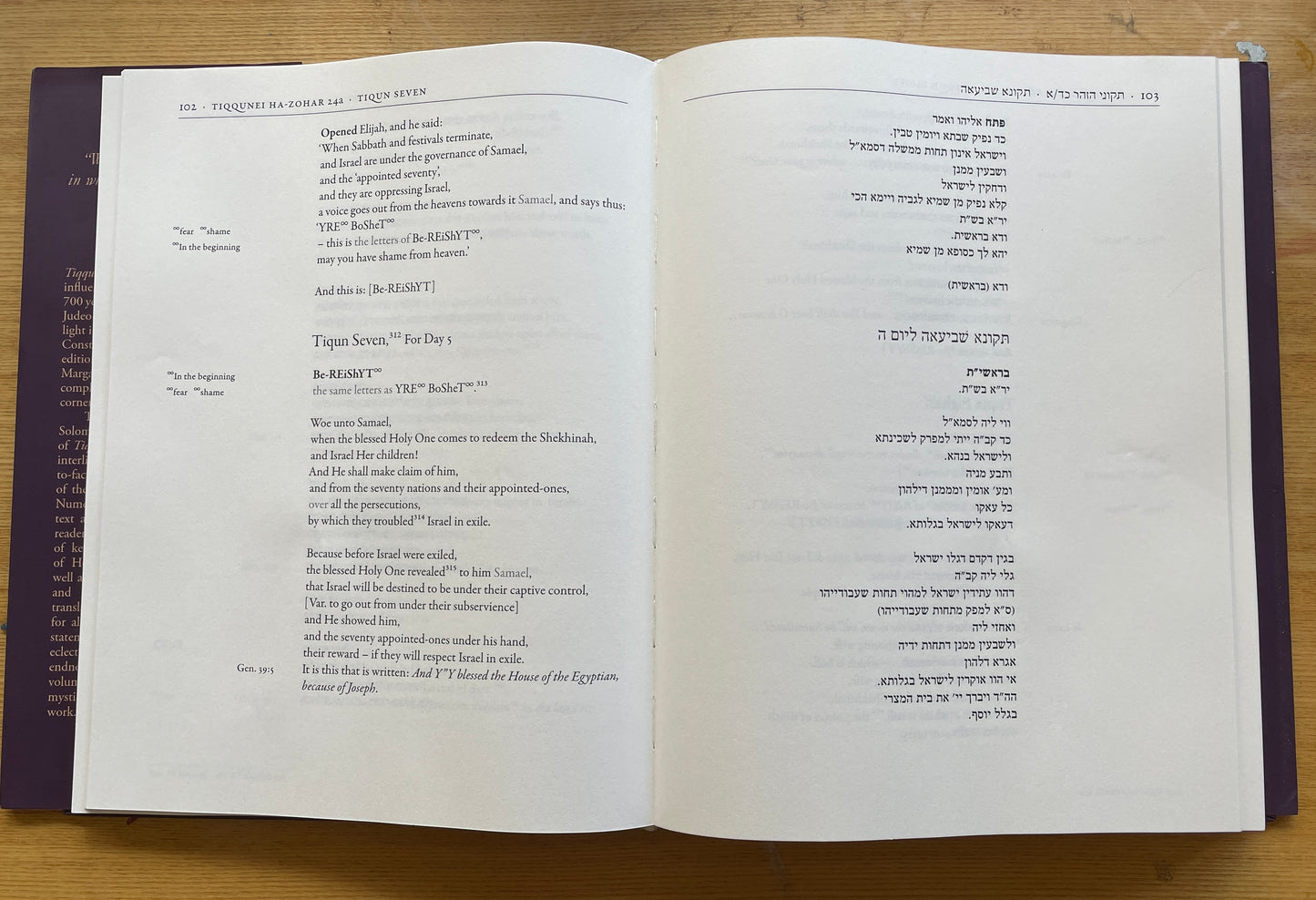
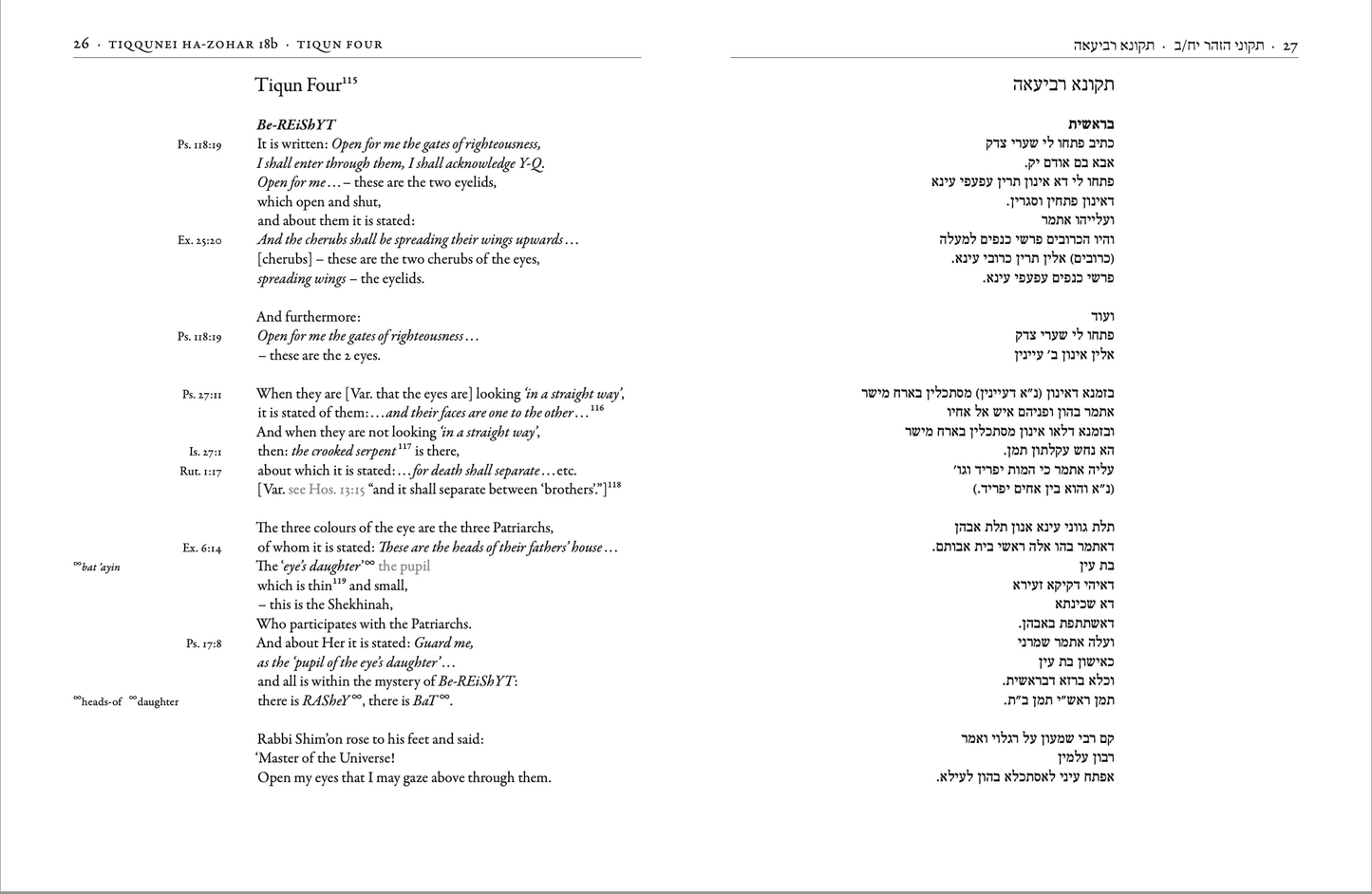

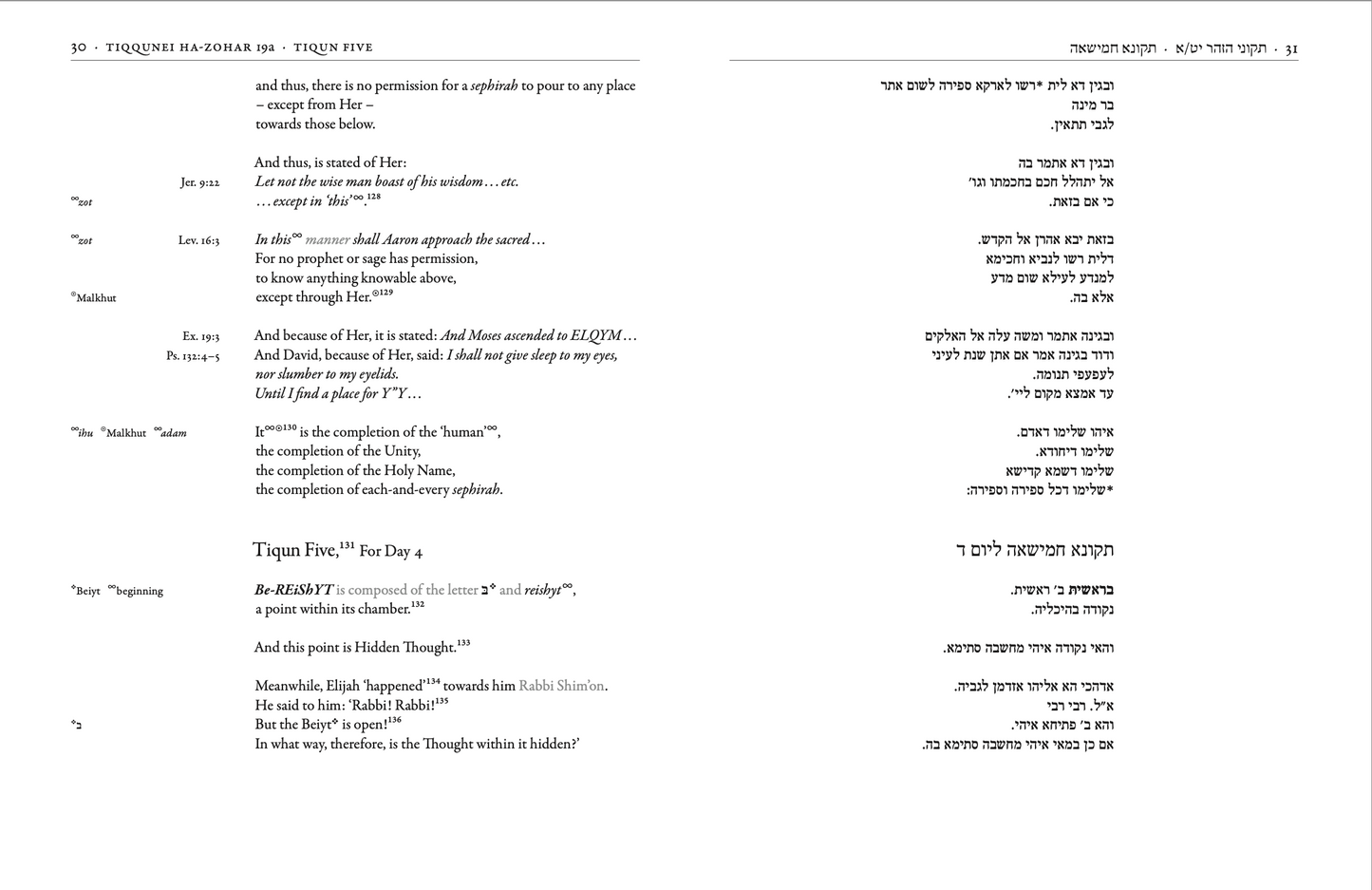
Please note: The above image of the TZM set is a digital rendering. The individual photographs are of a proto volume of volume 2. The final publication is likely to have some variations from these images.
WHAT OTHERS HAVE SAID
ABOUT TIQQUNEI HA-ZOHAR
“Even though the Book of the Zohar is very holy and awesome, it cannot compare to the holiness and mysteries of the book of the Tiqqunim.”
Rabbi Nachman of Breslov
ABOUT TIQQUNEI HA-ZOHAR MARGALYA
"Tiqqunei Ha-Zohar is the most important and influential kabbalistic book ever printed. David Solomon's annotated translation is a monumental achievement. These volumes are a necessary part of every Judaica collection, affording access to a broad readership as they advance the serious study of this kabbalistic classic."
Professor Daniel Abrams, Bar-Ilan University, and Editor, Kabbalah
INSIDE THE PUBLICATION
The forthcoming Tiqqunei ha-Zohar Margalya publication will appear as a bilingual, seven-volume set, with each volume approximately 400 pages in length. It will include:
- The full text of the definitive 1740 Constantinople (Qushta) edition of TZ, presented in poetic form, and retaining its mystical 'star paths'
- All Biblical, Talmudic and Midrashic sources, referenced on the pages of the translation
- Transliterations of keywords, where necessary for understanding
- Gematrias (numeric values) of keywords, where they are useful for understanding sense
- A translator’s annotation with insights into the ideas, themes, and symbols of the text, challenges in translation, and comparisons of different TZ editions
- An index of all Scriptural, Talmudic, and Midrashic sources quoted in TZ
- Structural and thematic summaries for each of the tiqqunim (chapters).
David Solomon has created an English translation of clarity and beauty which also preserves the poetry and cadence of the original Aramaic text.
TZM is presented in an eminently accessible format. Traditionally, Zoharic literature has appeared as blocks of dense text. However, in TZM, the Aramaic has been innovatively rendered into an easily readable line-by-line format. The English translation precisely reflects - in structure and style – this rendered Aramaic on each facing page, helping to unlock the text to readers from all backgrounds.
FREQUENTLY ASKED QUESTIONS
FAQs: Tiqqunei ha-Zohar in context
What are Zoharic texts?
Zoharic literature comprises a collection of profound texts of Jewish mysticism, most notably the Zohar and Tiqqunei ha-Zohar. These extraordinary works, composed in Aramaic, have fundamentally influenced the development of Kabbalah as well as Jewish thought and ritual over the past seven centuries. Each Zoharic text contains distinct mystical emphases, including scriptural commentaries and explorations of topics like the nature of God, the universe, souls, redemption, and more.
Who wrote the Zohar, the Tiqqunei ha-Zohar and the other Zoharic texts? And when did they write them?
Several of the Zoharic texts, including the Zohar, were revealed in Spain in the late 13th century, while others like the Tiqqunei ha-Zohar appeared in the early 14th century. Traditionally, the second-century sage and mystic Rabbi Shimon Bar Yochai is attributed as the author of all Zoharic texts. However, academic scholars contend they were likely composed by Spanish kabbalists from that period.
What are some key differences between the Zohar and the Tiqqunei ha-Zohar?
While both texts provide foundational and profound explorations of numerous topics of mysticism, they differ in style and subject matter. The Zohar offers a mystical commentary on the entire Torah. Tiqqunei ha-Zohar, on the other hand, comprises 70 chapters of commentary, known as tiqqunim, on the first word of the Torah: "Be-reishyt" ("In-the-beginning"). Although both texts are written in Aramaic, the literary style of TZ is regarded as denser and more challenging - perhaps partly explaining why it has taken longer to be translated.
Why is Tiqqunei ha-Zohar important?
Tiqqunei ha-Zohar (TZ) is arguably the most important - and difficult - of all the texts of Zoharic literature. As Rabbi Nachman of Breslov said: “Even though the Book of the Zohar is very holy and awesome, it cannot compare to the holiness and mysteries of the book of the Tiqqunim.”
The study of Tiqqunei ha-Zohar is said to repair a person's soul. There is a centuries-old kabbalistic custom to learn TZ through Elul and the Ten Days of Repentance until Yom Kippur, a period in the Jewish calendar of introspection and te-shuvah (repentance).
Key concepts of Jewish mysticism are believed to have emerged from TZ, including the idea of the “Four Worlds”. Additionally, the cornerstone Jewish mystical text Patach Eliyahu comes from TZ. Patach Eliyahu discusses the sephirot and their relationships to different parts of the human body. It also explores the infinite and unique nature of God.
FAQS: About the Tiqqunei ha-Zohar Margalya translation
Are there other translations of Tiqqunei ha-Zohar?
Unlike the Zohar, which has multiple English translations, the full text of Tiqqunei ha-Zohar has never before been translated into English or any other Western language in its entirety. However, incomplete English translations of parts of the text do exist elsewhere.
Is the Tiqqunei ha-Zohar Margalya a translation of a specific historical edition?
The TZM provides an English translation of the 1740 Constantinople (Qushta) edition of Tiqqunei ha-Zohar, considered by many scholars to be the definitive edition of the text. The TZM edition retains original elements of the 1740 Constantinople publication, including its introductions, star paths, and haskamot (rabbinical approvals).
Who is the translator?
David Solomon is a highly experienced translator of Hebrew and Aramaic texts, with a doctorate in sacred text translation. He is also the Managing Editor at Margalya Press.
Can you tell me more about the methodology behind this translation?
David Solomon, TZM's translator and editor, has sought to recreate the inherent beauty of the source-text Aramaic through a like-for-like documentary translation. His preference for accuracy over poetic interpretation means his translation is clear, accessible, and authentic.
David has used structure and presentation to optimise the reader's ability to engage with the text. For example, the Aramaic source text is rendered into short, accessible lines, in contrast with its traditional presentation as large blocks of text. This rendering is reflected in the English translation, presented in a parallel, mirrored, phrase-by-phrase format.
Breaking up the text ensures readers can easily compare the English translation with its Aramaic equivalent. This carefully designed arrangement also allows the poetic rhythm of the Tiqqunei ha-Zohar to be revealed fully and its meaning more easily uncovered.
Why do you spell it "Tiqqunei ha-Zohar" and not "Tikunei Zohar"?
Margalya Press uses the scholarly Hebrew/Aramaic to English translation convention in which a qof (ק) is represented as 'q' rather than 'k'.
Other examples of this convention are the English representation of ḥet (ח) as 'ḥ', and khaf (כ) and final khaf (ך) as 'kh'.
Does the Tiqqunei ha-Zohar Margalya translation have haskamot (rabbinical approvals)?
TZM contains those haskamot that were written and given to the 1740 Constantinople edition of Tiqqunei ha-Zohar. It does not include contemporary haskamot. David Solomon’s translation seeks to reflect accurately the language of the source-text Aramaic, in order to create as authentic a translation as possible.
FAQs: About the Tiqqunei ha-Zohar Margalya publication
Is the TZM translation six or seven volumes?
The complete TZM is seven volumes in total. Six of these volumes are translation, while the seventh volume contains the translator's annotated notes and other reference material.
Is there an electronic version of Tiqqunei ha-Zohar Margalya?
Margalya Press has partnered with Sefaria to enable the inclusion of Tiqqunei ha-Zohar Margalya to be offered among its collection (under a Creative Commons licence). As a result, TZM will be available for free online.
Why should I pay for a Tiqqunei ha-Zohar Margalya set when it will be available online?
Margalya Press believes that the Tiqqunei ha-Zohar Margalya physical edition is a thing of beauty and value that would grace the shelves of any serious home or institutional Jewish library.
We believe that the TZM seven-volume set is an important and desirable acquisition for people who appreciate Jewish texts and are in a position to invest in them.
A Stunning Production
TZM will come as seven elegant lay-flat hardcover volumes, with removable dust jackets, designed to enhance a reader's ability to study the text.
Internally, the pages have been carefully designed to maximise accessibility and create a pleasing aesthetic experience. The bilingual translation, presented on facing pages - with English on the left and Aramaic on the right – is clear, uncluttered, and beautiful.
Premium Features
The TZM set contains premium features exclusive to the seven-volume bilingual printed edition, including:
- An extensive overview essay of the text and its translation by David Solomon, translator and editor of TZM, provided in volume 1 of the set.
- As an English translation of the 1740 Constantinople edition, TZM also includes translations of the introductory pages and haskamot (rabbinical approvals) found within the original edition.
While Margalya Press is thrilled that anyone, regardless of location or income, will have access to the TZM translation, it believes that no online publication will match the multi-sensual experience of having the physical publication in hand.
We encourage anyone interested in this translation who has the means, to buy a set and place it proudly on their bookshelf. We are convinced that they will be glad they have done so.
Every purchase of publications like the Tiqqunei ha-Zohar Margalya helps to ensure the continuation of innovative Jewish publishing. By buying a set of TZM, you are supporting Margalya Press to produce more remarkable books - we have a fantastic pipeline of books waiting to be brought into the world.
Is there a softcover edition of the Tiqqunei ha-Zohar Margalya?
Although Margalya Press flagged the possibility of producing hard and softcover editions of Tiqqunei ha-Zohar Margalya, at present we have decided to proceed with the hardcover edition only.
When will the Tiqqunei ha-Zohar Margalya be completed?
Assuming there are no delays to the final stages of the Tiqqunei ha-Zohar Margalya production, we expect it to be available in print by the end of 2024.
What are the publication's specs?
The forthcoming Tiqqunei ha-Zohar Margalya publication will appear as a bilingual, seven-volume set, with an average volume size of 400 pages. Each volume is approximately 25cm tall (10") and 20cm wide (8"), presented in linen hardcover with dust jackets.
Will I have to pay for shipping?
Yes, customers will have to pay for shipping when they purchase TZM. See below for more information.
SHIPPING
The cost of shipping will vary according to your location. Margalya Press will do its utmost to find the best possible price for reliable shipping to your destination. In doing so, TZM sets will be shipped from either our US or Australian warehouses, depending on your location. Below are current estimates on shipping costs for Tiqqunei ha-Zohar Margalya to your country. These prices are based on current shipping quotes and may be subject to change. If you would like to purchase a set of TZM but live in a country not listed below, please contact us at hello@margalya.com to discuss further.
-
-
SHIPPING FROM AUSTRALIA
AU $40
Australia (outside of Melbourne)
US $70
New Zealand
US $100
China, Hong Kong SAR, Japan, Singapore, South Korea, Taiwan, Thailand
US $150
South Africa
-
SHIPPING FROM USA
US $30
USA
US $100
Canada
US $120
Mexico
US $130
France, Monaco
US $140
Austria, Belgium, Denmark, Finland, Germany, Gibraltar, Greece, Ireland, Italy, Luxembourg, Netherlands, Portugal, Spain
US $150
Bahrain,Cyprus, Malta, Israel & Palestinian Territories, Norway, United Kingdom, Sweden, Switzerland, United Arab Emirates
US $170
Bulgaria, Czechia, Estonia, Georgia, Hungary, Latvia, Lithuania, Moldova, Poland, Romania, Slovakia, Slovenia, Ukraine
-
Completion of theTiqqunei ha-Zohar Margalya production was assisted with the generous sponsorship of:









